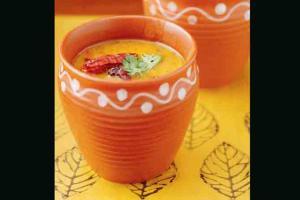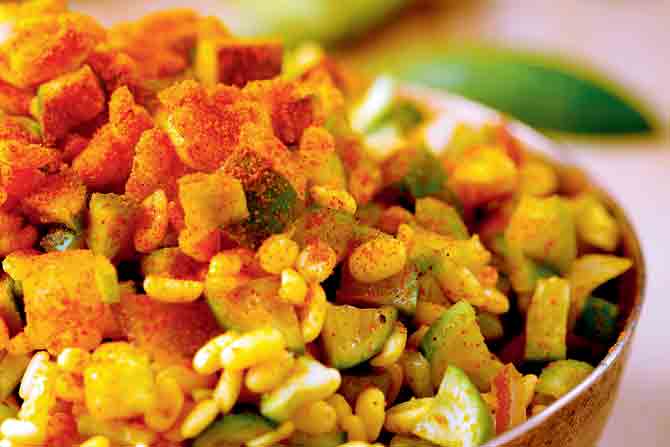We aren't talking about Mumbai's taxis but about dals. A workshop will trace its origin and diversity, and why it can easily become your lockdown staple

For the past couple of years, Rushina Munshaw Ghildiyal has been writing about and documenting the humble pulses and lentils of India. In fact, in 2018, she initiated the celebration of Dal Diwas on January 25. "Across India, there may be 40 to 50 variants — 30 used more commonly and 10 to 15 that are only locally available. Dals are split pulses of the bean, lentil and pea family. They are dicotyledons, which means they split into two. Rice, on the other hand, is a single grain or monocotyledon," Ghildiyal, author of A Pinch of This and Handful of That, explains.
Dissecting the dal
ADVERTISEMENT
Today, she will conduct an online workshop on the versatility of dals (pulses and lentils) in Indian cuisine that will re-introduce you to the rich history of the ingredient, the diversity of its use across the subcontinent, and its culinary versatility. Proceeds go to towards supporting the marginalised farmer community in the Himalayas. "In the evolution of our farming practices, dals and cereals are inter-cropped as they fortify the soil and replenish its nutrients. When we consume dal-rice (cereal and pulse), it provides the body with amino acids. In the lockdown, while it is the easiest to stock, it also ensures we have balanced nutrition and energy for all the house work," she jokes. In summer, dhuli moong (split yellow lentil), tur (split pigeon peas) and chana dal (split chickpeas) are most digestible followed by masoor (red lentils). "Moong is versatile. Soak it and have it raw in a salad. My cooker has conked off, and I've been making all my dals without it."
Tadka maar ke
While we love our tadka (tempering), the process is for addition of fat to help the body absorb the nutrients. Hing (asofoetida) is usually a constant ingredient in any tadka as it helps curb flatulence and lightens the process of digestion. Apart from the jeera (cumin)-hing or kadi patta (curry leaves)-rai (mustard) combinations, there are many variations to try at home. "Recently, I made a Kashmiri moong dal which I tempered in mustard oil with saunf (fennel) and sonth (dry ginger)."
Not without my meat

Rushina Munshaw Ghildiyal
"In non-vegetarian cooking, dal may be used as an ingredient to quantify a dish or meat/seafood may be added to flavour a dal. Also, we eat rice and roti, so we need gravy. In Bengal, dal is used to prepare macher matha, which is fish head cooked in moong dal. Parsis make dhansak where the dal is used to stretch the mutton, and add flavour," adds Ghildiyal.
Easy digestion
While some dals like masoor are heavier to digest in summer, she has an easy solution. When you soak it overnight and allow it to sprout, you process it outside, cooling its effect and making it more bio-available — the amount of nutrients of an ingredient that gets absorbed in the body. "I am mindful of serving some vegetables alongside dal, as it adds micro-nutrients that help the body absorb the goodness of dal." she signs off.
On April 24, 11 am to 12 pm
Log on to greenpeopleind@gmail.com to register
Call 9833487433
Cost Rs 799
Dal soup
Ingredients
For the soup
- Masoor dal (washed thoroughly under cold running water) 1 cup
- Onions 3-4
- Tomatoes 6 (large)
- Garlic cloves 5-6
- Ginger 1-inch piece
- Chilli powder 1/2 tsp
- Salt to taste
- Water (or stock) 6 cups
For the tempering
- Ghee 1 tbsp
- Bay leaves 2
- Cinnamon 1/2 inch sticks
- Cloves 3-4
- Curry powder 1/2 tsp
Method
Combine everything under the for-the-soup section and pressure-cook for one whistle (or cook in a pan till the lentils are cooked through and are tender). Cool a little and process in a blender. Strain and return to a large pot. Temper just before you serve. To temper (if the soup has cooled down, reheat before you start with tempering) heat the ghee, add the spices and stir till an aroma is released. Add the curry powder and give it a quick stir. Quickly pour tempering over the boiling soup, stir and cover. Serve with chopped onions, lemon wedges and buttered fresh pav on the side.
Tindola (ivy gourd) and moong dal salad

Ingredients
- Ivy gourd (tindola), finely diced 1 cup
- Chilli powder 1/2 tsp
- Lime juice 1/2 tsp
- Green chillies, finely chopped 1 or 2
- Yellow moong dal (soaked for four hours) 1/2 cup
- Fresh coriander, finely chopped 2 tbsp
- Fresh coconut, grated (optional) 1 tbsp
- Salt to taste
Method
Combine the tindola with salt, lime juice and chilli powder. Toss well and leave for a while till the tindola lets off its juices. Drain and rinse moong dal. Add to the bowl along with chilli. Mix well and add chilli. Serve garnished with coriander leaves and grated coconut.
Catch up on all the latest Mumbai news, crime news, current affairs, and a complete guide from food to things to do and events across Mumbai. Also download the new mid-day Android and iOS apps to get latest updates.
Mid-Day is now on Telegram. Click here to join our channel (@middayinfomedialtd) and stay updated with the latest news
 Subscribe today by clicking the link and stay updated with the latest news!" Click here!
Subscribe today by clicking the link and stay updated with the latest news!" Click here!







